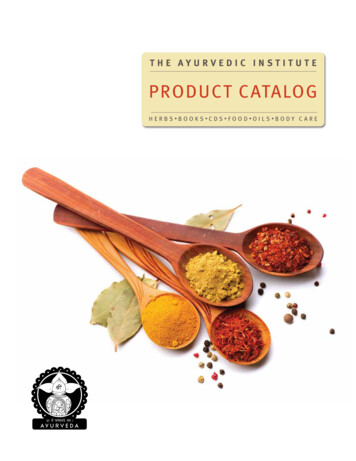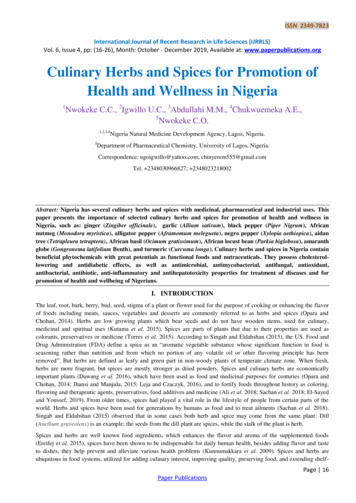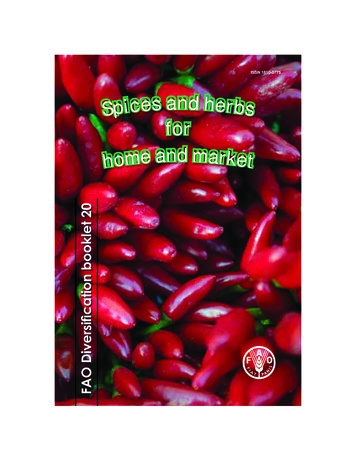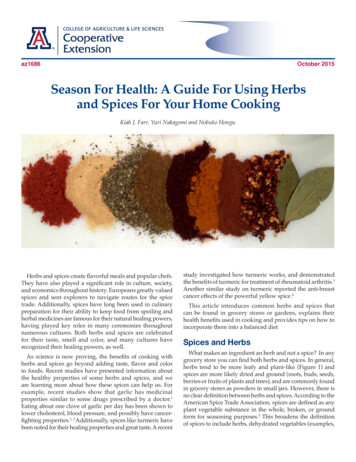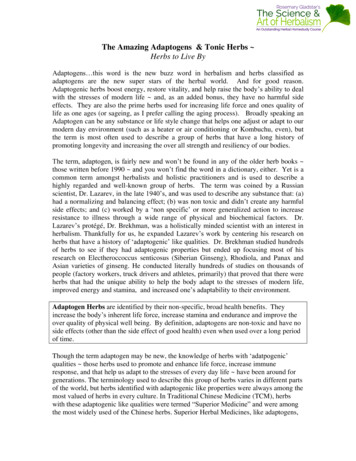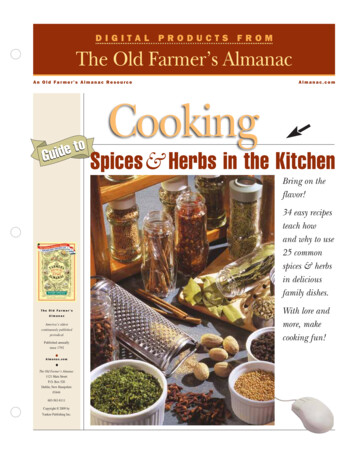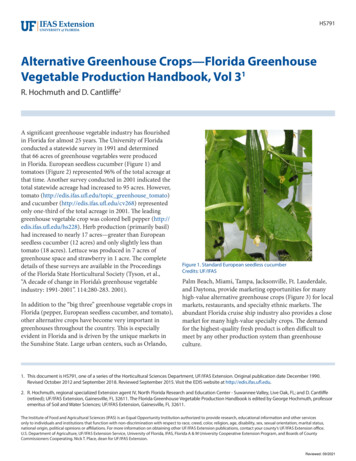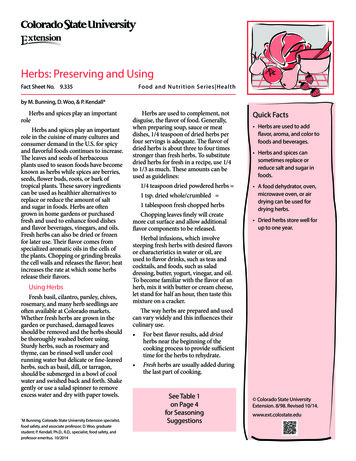
Transcription
Herbs: Preserving and UsingFact Sheet No. 9.335Food and Nutr ition S er ies Healthby M. Bunning, D. Woo, & P. Kendall*Herbs and spices play an importantroleHerbs and spices play an importantrole in the cuisine of many cultures andconsumer demand in the U.S. for spicyand flavorful foods continues to increase.The leaves and seeds of herbaceousplants used to season foods have becomeknown as herbs while spices are berries,seeds, flower buds, roots, or bark oftropical plants. These savory ingredientscan be used as healthier alternatives toreplace or reduce the amount of saltand sugar in foods. Herbs are oftengrown in home gardens or purchasedfresh and used to enhance food dishesand flavor beverages, vinegars, and oils.Fresh herbs can also be dried or frozenfor later use. Their flavor comes fromspecialized aromatic oils in the cells ofthe plants. Chopping or grinding breaksthe cell walls and releases the flavor; heatincreases the rate at which some herbsrelease their flavors.Using HerbsFresh basil, cilantro, parsley, chives,rosemary, and many herb seedlings areoften available at Colorado markets.Whether fresh herbs are grown in thegarden or purchased, damaged leavesshould be removed and the herbs shouldbe thoroughly washed before using.Sturdy herbs, such as rosemary andthyme, can be rinsed well under coolrunning water but delicate or fine-leavedherbs, such as basil, dill, or tarragon,should be submerged in a bowl of coolwater and swished back and forth. Shakegently or use a salad spinner to removeexcess water and dry with paper towels.M Bunning, Colorado State University Extension specialist,food safety, and associate professor; D. Woo, graduatestudent; P. Kendall, Ph.D., R.D., specialist, food safety, andprofessor emeritus. 10/2014*Herbs are used to complement, notdisguise, the flavor of food. Generally,when preparing soup, sauce or meatdishes, 1/4 teaspoon of dried herbs perfour servings is adequate. The flavor ofdried herbs is about three to four timesstronger than fresh herbs. To substitutedried herbs for fresh in a recipe, use 1/4to 1/3 as much. These amounts can beused as guidelines:1/4 teaspoon dried powdered herbs 1 tsp. dried whole/crumbled 1 tablespoon fresh chopped herbsChopping leaves finely will createmore cut surface and allow additionalflavor components to be released.Herbal infusions, which involvesteeping fresh herbs with desired flavorsor characteristics in water or oil, areused to flavor drinks, such as teas andcocktails, and foods, such as saladdressing, butter, yogurt, vinegar, and oil.To become familiar with the flavor of anherb, mix it with butter or cream cheese,let stand for half an hour, then taste thismixture on a cracker.The way herbs are prepared and usedcan vary widely and this influences theirculinary use. For best flavor results, add driedherbs near the beginning of thecooking process to provide sufficienttime for the herbs to rehydrate. Fresh herbs are usually added duringthe last part of cooking.See Table 1on Page 4for SeasoningSuggestionsQuick Facts Herbs are used to addflavor, aroma, and color tofoods and beverages. Herbs and spices cansometimes replace orreduce salt and sugar infoods. A food dehydrator, oven,microwave oven, or airdrying can be used fordrying herbs. Dried herbs store well forup to one year. Colorado State UniversityExtension. 8/98. Revised 10/14.www.ext.colostate.edu
Wrapping whole herbs in acheesecloth bag before addingthem to cooked dishes makesremoval easy before serving. Herbs in uncooked foods, suchas salad dressings, dips and fruitmixes, need time to blend flavors,so add them as far in advance ofserving as possible. Basil, cilantro, dill, mint, oregano,parsley, rosemary, sage, savory,tarragon, and thyme add interestto salads; rosemary, thyme or basilmay be added as a secondary flavorto sorbet or summer beverages.Some herbs are best used fresh—such as burnet, chervil, andparsley—because they have littleflavor once dried or frozen.Herb Flavored Vinegars and Oils.Herbs may be added to vinegar or oiland used in the seasoning of saladsand sauces. It is important to storehomemade herb infused oils in therefrigerator and use within four daysbecause they have the potential tosupport the growth of Clostridiumbotulinum bacteria. CommerciallyFor more informationon preparing and usingflavored vinegars and oils,see CSU Extension fact sheet9.340, Flavored Vinegars and Oilsmade herb/oil mixtures are often storedat room temperature but this is becauseof special processing or acidificationsteps. Always check the label beforestoring.Herbal Teas and Beverages.Traditionally, a true tea is made fromthe leaves of the tea plant, Camelliasinensis. Beverages made from theleaves, flowers, bark or roots of otherplants have become widely knownas herbal teas. Herbal teas do not gothrough the same curing process asblack or green tea so it is importantto brew herbal teas using water thathas been heated to a temperaturehigh enough to destroy harmfulmicroorganisms. It is recommendedto brew herbal teas at 180-200 F for5-15 minutes. Brewed herbal tea canbe chilled for use as iced tea. Herbsor herbal teas should not be used inmaking tea which is not brewed, suchas sun tea; however, after cooling,brewed herbal tea can be added to suntea that has been made with black tealabeled for cold brewing use.Drying and Storing HerbsDrying is the traditional method forpreserving herbs. To minimize wiltingand maximize flavor, gather herbs inthe morning of a dry day, just after dewhas evaporated. Rinse thoroughly anddry with paper towels. Because manyherbs look alike when dry, label thembefore you dry them. Herbs are drywhen they are crispy, crumble easily,For more informationon using herbs for health,see CSU Extension fact sheet9.370, Herbals for Health?and stems break. When collecting theseeds of herbs, try drying inside a paperbag with holes cut in the side of thebag. Sun drying is not recommendedbecause of the potential for insectinfestation and loss of flavor and color.Food Dehydrator. Drying herbswith a commercial food dehydratortypically allows for better control oftemperature within the recommendedtemperature range. Arrange herbs ondrying trays in single layers; good aircirculation between trays is important.The National Center for Home FoodPreservation recommends pre-heatingthe dehydrator with the thermostat setto 95 º F to 115 º F. In areas with higherhumidity, temperatures of 125º F maybe required. Check your dehydratorinstruction booklet for specific details.See Table 2on Page 4for Herb FlavorCharacteristicsCan homemade pestobe canned?Pesto, a spicy green paste wellknown for flavoring pasta dishes,is an uncooked seasoning mixtureof herbs, often including freshbasil, garlic, olive oil, pine nutsand cheese. There are no homecanning recommendations but itmay be stored frozen. Preparedpesto may be frozen in smallfreezer containers or in ice cubetrays (2 tablespoons per cube).Another option is to freeze in asquare pan, covered with plasticwrap. When completely frozen,cut into cubes and transfer to aresealable plastic freezer bag.Frozen pesto will store for up to 6months. Thaw pesto cubes for 15minutes at room temperature or at30-second intervals in a microwaveoven until soft. Mash with a forkbefore using in recipes.Gas or Electric Oven. The oven lightof an electric range or the pilot light of agas range may furnish enough heat forovernight drying of herbs. Place singlelayer of herbs on oven-safe trays.Microwave Oven. Drying in amicrowave oven can be a good optionfor small amounts of herbs and appearsto be the best drying method forreducing microbial contaminationof herb leaves. Check the microwaveoven owner’s manual for specific herbdrying directions. Make sure herbsare thoroughly dry before placing inthe microwave oven so that residualwater does not cause the herbs to cookinstead of dry. To dry, place a singlelayer of herbs between two paper towelson a microwave-safe plate. Avoid usingpaper towels made from recycledmaterials as they may contain metalparticles which could cause sparking inthe microwave oven. Place a ½ cup ofwater in 1 cup measure next to plate ofherbs.Some herbs, such as basil, shouldbe dried on the microwave ovens ‘low’setting. It is important to stop every
15 seconds to check the herbs andperiodically turn them over. Althoughsome microwave drying instructionssuggest a longer time, in Colorado’s dryclimate it is necessary to check every 15seconds to reduce the risk of fire and/orcharring of the herbs.Air Drying. Air drying is theleast expensive method but offersthe least amount of consistency indrying and the greatest opportunityfor contamination with bacteria ordust. Tie two to three sprigs of freshherbs at the base of stems with twineand hang away from direct sunlight atroom temperature or lay on cheeseclothstretched on frames or netting screens.This method may be used for sturdierherbs. More tender leaf herbs—suchas basil, tarragon, lemon balm, andmint—are higher in moisture andshould be dried quickly, using one ofthe previous methods, to prevent moldgrowth.Storing Dried Herbs. Dried herbsshould be stored in a cool, dry placeand most will keep well for up to ayear. Their strength can be judgedby their aroma. Dried herbs can bestored whole or crushed, but wholeherbs retain their flavor longer. Toensure optimum quality, store in rigid,opaque containers with airtight seals.Choose ceramic jars or darkened glasscontainers to help protect the herbsFor more informationon dehydration methods,see CSU Extension fact sheet9.308, Drying Vegetables and9.309, Drying Fruitsagainst light deterioration. Make sureherb leaves are completely dry toprevent mold growth during storage.Label all storage containers with theherb's name and dateFreezing HerbsQuick-frozen herbs will keep up toone year in the freezer if well packaged.To tray-freeze herbs, wash them, thendrain and pat dry. Strip leaves off stems,General Guide for Microwave DryingMicrowaveOven Wattage500-600watts650-700wattsApproximateDrying Time3-6minutes2-4minutesspread leaves in a single layer on acookie sheet; place in freezer for at least30 minutes. Place the frozen leaves ina freezer bag. Label with herb’s name,date, and return to freezer for use asneeded. Cut leaves like basil can alsobe frozen in ice cube trays half filledwith water. Add 1 tablespoon choppedleaves to each section of the ice cubetray. Press herbs under water as muchas possible. Freeze overnight. The nextday, top off the ice cube trays so theherbs are completely submerged inwater and re-freeze. When frozen, popout the cubes and stored in a labeledand dated freezer bag. Frozen herbs arebest used in cooked dishes as they willbecome limp when thawed.Table 3 summarizes the flavorprofile, harvesting, preservationmethods and culinary uses for severalherbs that can be grown or purchasedfresh in Colorado. Many popular herbare members of the mint (Lamiaceae)and carrot (Apiaceae) families.For more informationon growing herbs in Colorado,see CSU Extension Planttalkscript 1003, Planning & Plantsfor an Herb Garden750-1200watts1-2minutesReferencesAnderson, J. and J. Roach. 2009. Herbalsfor Health? CSU Extension Fact Sheetno. 9.370. all, P. and J. Rausch. 2006. FlavoredVinegars and Oils. CSU Extension FactSheet no. 9.304. all, P., P. DiPersio and J. Sofos. 2008.Drying Vegetables. CSU Extension FactSheet no. 9.308. nal Center for Home FoodPreservation. Drying Herbs. www.uga.edu/nchfp/how/dry/herbs.html.National Heart Lung and Blood Institute,National Institutes of Health (NHLBI/NIH), Flavor That Food, mmer, B.A., Schaffner, D., Frazer, A. andE.L. Andress. 2011. Current Food SafetyIssues of Home-prepared Vegetablesand Herbs Stored in Oil. FoodProtection Trends, 31 (6): 336-342.Snider, S. 2007. Using Herbs and Spices.University of Delaware CooperativeExtension. de/fnf-03.pdf.Woo, D. 2010. Microbial Quality of MixedSalad Greens and Selected Fresh andDried Herbs. M.S. Thesis. Dept. of FoodScience & Human Nutrition, ColoradoState University.Youger-Comaty, J. 2010. Growing, Selectingand Using Basil, Ohio State UniversityExtension Fact Sheet. http://ohioline.osu.edu/hyg-fact/1000/1644.html
Figure 1. Herbs: parsley, rosemary, mint, and sage, Gardens on Spring Creek, Fort Collins,Table 1. Seasoning suggestions. These herbs, spices and other seasoning may serve as alternatives to salt(modified from NHLBI, 2011). Suggested seasonings are not intended to all be used together; experiment withmixing different herbs to suit your preferences.FoodHerbs and other seasonings to enhance flavorMeatBeefBay leaf, marjoram, nutmeg, onion, pepper, sage, thymeLambBasil, curry powder, garlic, mint, rosemaryPorkGarlic, onion, oregano, pepper, sageChickenMarjoram, oregano, parsley, rosemary, saffron, sage, tarragon, thymeFishBasil, chervil, chives, dill, marjoram, dry mustard, paprika, pepperVegetablesCarrotsCinnamon, cloves, marjoram, nutmeg, rosemary, sageCornCilantro, cumin, curry powder, paprika, parsley, onionGreen BeansCurry powder, dill, lemon juice, marjoram, oregano, tarragon, thymeGreensOnion, red pepperPeasGinger, marjoram, mint, onion, parsley, sage, gingerPotatoesBay leaves, chives, dill, paprika, parsley, sage, garlic, onionSummer SquashMarjoram, rosemary, sage, cloves, curry powder, nutmegWinter SquashCinnamon, ginger, nutmeg, onionTomatoesBasil, bay leaf, chives, dill, marjoram, oregano, parsley, pepperEggsBasil, chives, chervil, dill, marjoram, parsley, paprika (hard cooked eggs) tarragonYogurtBasil, chives, lemon thyme, marjoram, mint, sageButterChives, dill, garlic, mint, parsleyTable 2. Flavor characteristics of common culinary herbs (Modified from Snider, 2007).FlavorHerbsCharacteristicsDelicateBurnet, chervil, chives, parsleyMay be used in fairly large quantities;combines well with most other herbsMediumBasil, celery leaves, tarragon,marjoram, mint, oregano,savory, thymeUse in moderate amounts(1-2 teaspoons dried herbs for 6 servings)StrongBay leaf, rosemary, sageWill impart a dominant flavorSweetMintGives a cool burst of flavor to meat, seafood,and sweet dishesSavoryOregano, tarragon, chives, dillOften used to flavor meat, egg and cheese dishes
Table 3. Herb Characteristics and Preservation Information.Characteristics/Culinary UsesPreservingAnise (seeds), Pimpinella anisum; Carrot FamilyUsed to flavor cookies, candies, pickles, beverages, breads, and fig dishes.Cut stems of seed heads after seeds have developed but while they are stillgreen. Tie the stalks in small bunches and suspend inside a paper bag withholes punched in the sides. Suspend the bag in a dark area with food aircirculation. When dry, shake the bag well and collect the seeds; store inlight-proof airtight containers.Basil, sweet (leaves), Ocimum species; Mint FamilyTender green leaves have sweet flavor with wild pungency. Used in pestoand Italian and Thai dishes. Excellent with tomatoes, cheese, green salads,eggs, yogurt, soups, stews, lamb, and fish.When the plant starts to flower, cut stems 6 to 8 inches above ground,about ¼ inch above a stem node. Wash leaves well before drying orfreezing. Basil dries well in microwave oven at a low setting. When dry,leaves will crumble easily. Store whole or crushed in airtight containers.To freeze, pack washed leaves in ice cube trays half-filled water, pressingleaves under water as much as possible. Freeze overnight. Top off the traysso the leaves are completely submerged in water and re-freeze. Whenfrozen, remove cubes and store in label and dated plastic bags. Defrost in astrainer and use as fresh.Bay (leaves), Laurus nobilis; Laurel FamilyLeaves are aromatic with a sweetish odor and pungent flavor. A classicingredient in French bouquet. Used in sauces, pickling, stews, and withmeats and potatoes. Bay leaves are tough and should be removed beforeserving. Complements tomatoes, beans, potatoes and beef.Pick individual leaves to use fresh or preserve. When dry, pack in airtightcontainers. Freeze as for basil.Burnet, Sanguisorba minor; Rose FamilyPerennial herb with a light cucumber flavor; used in flavoring butter,cottage cheese, cream cheese, potato salads and salad dressings.Select young leaves, older leaves may be bitter. May be used in place ofmint leaves but does not keep flavor well when dried or frozen.Caraway (seeds), Carum carvi; Carrot FamilyMostly used whole in rye breads, sauerkraut, cheeses, potato salads, meatsand stews.Cut plants to ground level when flowers and stalks turn grayish-brown,about a month after flowering. For air drying, see anise; seeds shake outeasily when fully ripe. Store in airtight containers.Chervil (leaves), Anthriscus cerefolium; Carrot FamilyHas a light, licorice flavor with a wild taste of pepper. Gives pleasant flavorto salads and salad dressings, meats, fish, soups, omelets and stews.Pick only young, tender leaves just before the buds break, fresh chervil hasa short storage life. Dry or freeze as for basil.Chives (leaves), Allium schoenoprasum; Onion FamilyFlavor is similar to green onion, but milder and finer leaves. Used for light,oniony flavor in salads, dips, sauces, vegetables, soups, fish, etc.Use leaves fresh by snipping off the tops with scissors. Chives lose theircolor and flavor when dried. To freeze, wash and chop finely, thencontinue as for basil.Cilantro, Coriandrum sativum; Carrot FamilyUsed in Asian and Latin American dishes. Goes well with corn,cucumbers, avocado, rice, fish, and chili peppers.High heat reduces flavor. Freezes well in ice cube trays. Dry or freeze asfor basil.Note: Cilantro leaves contain chemicals called aldehydes which imparta flavor characteristic which is disagreeable to some people.Coriander (seeds), Coriandrum sativum; Carrot FamilySmall, orange-flavored seeds used in cold cuts, curry powder, cakes,cookies, poultry dressings, French dressing and Scandinavian cooking.Same plant is source of cilantro.For air drying, see anise. When seeds are dry, shake out of heads and storein airtight containers. Flavor improves if stored a month before using.Dill (seeds, leaves), Anethum graveolens, Carrot FamilySeeds have slightly bitter taste. Used in soups, pickles, cheese dishes,breads, sauces, meats and fish. Dill weed has delicate bouquet. Used toflavor fish sauces, salads, dips, potatoes and meats.Pick young leaves just as flowers open. Cut leaves and spread in a thinlayer to dry until brittle. Crumble leaves and store in an airtight container.To collect seeds, cut flower umbel stalks or pull entire plant from ground.See instructions for anise seeds; store in airtight containers.Fennel (stems, leaves, seeds), Foeniculum vulgare; Carrot FamilyYellowish-brown seeds with sharp, sweet, licorice-like flavor; used to flavor Young stems can be used like celery. Pick young leaves to dry, as for basil.sausages, breads, salads, salad dressings, pickles, cheese spreads, soups and Cut off flower stems before seeds fall. Store in airtight containers.sauces. Leaves garnish or flavor sauces and salads.
Table 3 continued. Herb Characteristics and Preservation Information.Horseradish (root, leaves), Armoracia rusticana; Mustard FamilyHome prepared horseradish is about twice as strong as store-bought andlasts 3 to 4 weeks in the refrigerator. Excellent with roasted and smokedmeats. Young leaves may be added to salads.Rinse the horseradish roots well. Horseradish has potent volatilecompounds so work in a well-ventilated room, or outdoors, and protectyour eyes. Peeling under water will help contain the volatile oils. Chop in afood processor with a small amount of water. A basic horseradish recipe is:1 root 4 Tbsp water, add 2 Tbsp vinegar, ½ tsp salt. Transfer to a jar andrefrigerate. Excess shredded root may be sealed in freezer bags and frozenup to 6 months.Marjoram, sweet (leaves), Origanum majorana; Mint FamilyGray-green leaves with slightly bitter undertone. May be used fresh ordried to season vegetables, lamb, sausage, eggs, poultry, cheese dishes,potato salad, stuffings and soups.Cut stems just before buds begin to flower, leaving a few leaves to send upanother crop. Dry as for basil. When dry, crumble and store in airtightcontainers. To freeze, follow tray freezing directions above or pack smallbunches in plastic bags and place in freezer. Blanch before freezing ifstoring more than 2-3 months.Mint, spearmint, peppermint, apple mint, orange mint (leaves); Mint FamilyRefreshing odor and flavor. Often used as garnish. Flavor combines wellwith lamb, peas, fish sauces, yogurt, candies, chocolate and vegetables.Crush leaves just before adding to a dish.Pick young, fresh leaves to dry. Dry or freeze as for basil.Oregano (leaves), Origanum species; Mint FamilyFlavor similar to sweet marjoram, but stronger and more sage-like.Liberally used in Spanish and Italian dishes, pizza; component of chilipowder.See sweet marjoram for preserving instructions.Parsley (leaves), Petroselinum crispum; Carrot FamilyFinely curled, aromatic leaves are rich in vitamins A and C. Used asflavoring or garnish for soups, salads, eggs, meat and poultry dishes,creamed vegetables and hot breads.Parsley can be dried or frozen as for basil, but the flavor is better if frozen.Rosemary (leaves), Rosmarinus officinalis; Mint FamilyLeaves have a spicy odor and warm, piney taste. Used as a garnish and toflavor vegetable and meat dishes, cream soups, sauces and jellies. Makes agood tea.Air or microwave drying works well for rosemary and other sturdy herbs;when dry, rub leaves from stem and store in airtight containers.Saffron, Crocus sativus; Iris FamilyYellow stigmas are pleasantly bitter, give a yellow hue to foods. Usedsparingly in sauces, cookies, cakes, chicken, gravies and Spanish rice.Remove stigma in late fall and dry on a cloth in a warm room. Store stigmain airtight containers.Sage (leaves), Salvia officinalis; Mint FamilyStrong bitter flavor. Used sparingly in stuffings, soups, stews, sausage andherb breads.Pick leaves in spring before flower buds form, or flavor becomes musty.Dry or freeze as for basil. To store more than three months, blanch beforefreezing.Summer savory (leaves), Satureja hortensis; Mint FamilyUsed in poultry, soups, gravies, stuffings, salads, bean dishes; sauces forfish or veal.Cut leafy tops and use only young, tender leaves. Remove woody stems.Dry as for basil.Tarragon (leaves), Artemisia dracunculus; Sunflower FamilyConsidered essential in many French dishes; goes well with eggs, poultry,fish, shellfish and many vegetables. Used as flavoring in pickles andvinegar.Use fresh young leaves and stem tips. Dry or freeze as for basil.Thyme (leaves), Thymus vulgaris; Mint FamilyThe leaves have unexcelled aroma and flavor. Good with roast meats, fishchowders, sauces, soups, gumbos, stews, stuffings and salads. Makes aflavorful tea.Cut sprigs before the plant flowers. After drying, rub leaves from stemsand store in airtight containers. Freeze as for sage.Colorado State University, U.S. Department of Agriculture and Colorado counties cooperating. CSU Extension programs are available to all without discrimination. Noendorsement of products mentioned is intended nor is criticism implied of products not mentioned.
Herbs are used to complement, not disguise, the flavor of food. Generally, when preparing soup, sauce or meat dishes, 1/4 teaspoon of dried herbs per four servings is adequate. The flavor of dried herbs is about three to four times stronger than fresh herbs. To substitute dried herbs for fresh in a recipe, use 1/4 to 1/3 as much. These amounts .
